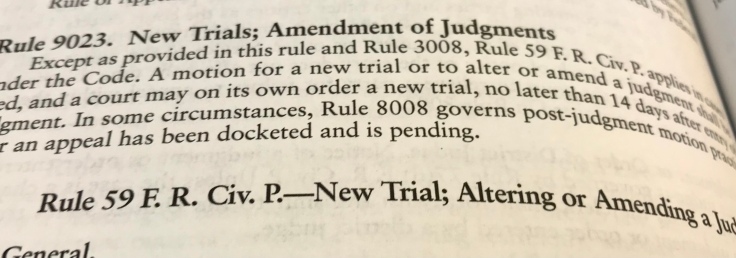
By: Donald L Swanson
Imagine this: a U.S. District Court enters judgment in a case that’s “related to” a bankruptcy, and we want to file a motion for new trial or to amend the judgment.
So, which deadline applies to the motion:
- 28 days under Fed.R.Civ.P. 59(e); or
- 14 days under Fed.R.Bankr.P. 9023?
That’s the precise question before the U.S. Supreme Court, under a Petition for a writ of certiorari in Roy v. Canadian Pacific Railway Co. (Case No. 21-1047):
Petitioner discovers the hard way, in litigation before a district court, that the court will apply the 14-days rule when it is exercising “related to” jurisdiction under 28 U.S.C. § 1334. Petitioner is asking the U.S. Supreme Court to adopt the 28-days rule, instead.
Facts
Here is a simplified version of complicated facts.
–Catastrophe
On July 6, 2013, forty-seven people die in the town of Lac-Mégantic, Québec, when an unattended train carrying volatile crude oil derails and erupts outside their homes in the middle of the night. More than a million gallons of oil spill into the town’s streets, homes, and businesses before going up in flames, leveling a significant portion of the town.
–Bankruptcy Filing
On August 7, 2013, the entity operating the derailed train files bankruptcy in Maine—the bankruptcy remains pending.
–Lawsuits and “Related to” Jurisdiction
Wrongful-death lawsuits are filed in various state courts against multiple defendants. Such lawsuits are then:
- removed by defendants to federal district courts under 28 U.S.C. § 1334, because the lawsuits are “related to” the train operator’s bankruptcy; and
- transferred to the U.S. District Court for the District of Maine under 28 U.S.C. § 157(b)(5), at the requests of plaintiffs and the bankruptcy trustee, because that’s where the bankruptcy case is pending.
–Settlements, Remaining Defendant & Dismissal
Settlements occur, and all-but-one of the defendants are dismissed from the lawsuit, with prejudice.
Plaintiffs file an amended complaint against the remaining defendant.
The amended complaint is then dismissed by the District Court (on September 28, 2016) for failing to state a claim. The District Court also denies Plaintiffs’ motion for leave to file a second amended complaint—“for futility.”
–Post-Dismissal Filings
On October 26, 2016 (28 days after entry of the dismissal order), plaintiffs file their “Motion to Reconsider Court Orders,” specifying that such Motion is:
- made “pursuant to Rule 59(e) of the Federal Rules of Civil Procedure” (subpart (e) is titled “Motion to Alter or Amend a Judgment”); and
- “to reconsider the order entered on September 28, 2016.”
On January 9, 2017, the District Court denies plaintiffs’ Motion to Reconsider.
Appeal to First Circuit
Plaintiffs appeal to the First Circuit Court of Appeals.
On June 2, 2021, the First Circuit rules: “The plaintiffs’ attempted appeal is untimely and must be dismissed for want of appellate jurisdiction.” That’s because the 14-days deadline in Bankruptcy Rule 9023 controls—not the 28-days deadline in Civil Procedure Rule 59(e).
The First Circuit’s opinion is lengthy. The gist is this:
- When a federal district court’s jurisdiction is based on 28 U.S.C. § 1334 (i.e., “related to” a bankruptcy case), Federal Rules of Bankruptcy Procedure control—not Federal Rules of Civil Procedure;
- Citing, In re Celotex Corp., 124 F.3d 619, 629 (4th Cir. 1997); Phar-Mor, Inc. v. Coopers & Lybrand, 22 F.3d 1228, 1238 (3d Cir. 1994); Diamond Mortg. Corp. of Ill. v. Sugar, 913 F.2d 1233, 1243 (7th Cir. 1990); and Double Eagle Energy Servs., L.L.C. v. MarkWest Utica EMG, L.L.C., 936 F.3d 260, 264 (5th Cir. 2019).
Petition for Certiorari
By contrast, Plaintiffs file a Petition for writ of certiorari with the U.S. Supreme Court, insisting that:
- “Rules 9023 and 9024—the bankruptcy analogues to Rules of Civil Procedure 59 and 60” apply “only to appeals from the bankruptcy court to the district court, and not to appeals from the district court to the court of appeals.”
The Petition:
- Cites, In re Butler, Inc., 2 F.3d 154, 155 (5th Cir. 1993); In re Bli Farms, P’ship, 465 F.3d 654, 658 (6th Cir. 2006); and English-Speaking Union v. Johnson, 353 F.3d 1013, 1019 (D.C. Cir. 2004); and
- Adds that such a conclusion “is the only one consistent with the bankruptcy rules’ plain language, which provide that Rule 9023 motions toll the time to appeal the judgment ‘of a bankruptcy court.’ Fed. R. Bankr. P. 8001(a) (emphasis added).”
Amici Brief of Law Professors
A group of law professors, who “teach or write on civil procedure or federal courts,” take this position in an amici brief filed on February 28, 2022:
- “the decision below erred in its understanding of the applicability of the rules governing bankruptcy, with troubling and far-reaching implications that will affect a wide range of cases”; and
- “the First Circuit’s novel approach would”:
- “subjugate the Civil Rules to the Bankruptcy Rules in a way never contemplated in promulgating the two sets of separate rules”; and
- “fail to achieve the uniformity of approach that apparently motivated the First ruling below.”
Conclusion
It will be interesting to see what the U.S. Supreme Court does with the Petition for a writ of certiorari in Roy v. Canadian Pacific.
** If you find this article of value, please feel free to share. If you’d like to discuss, let me know.
Leave a comment